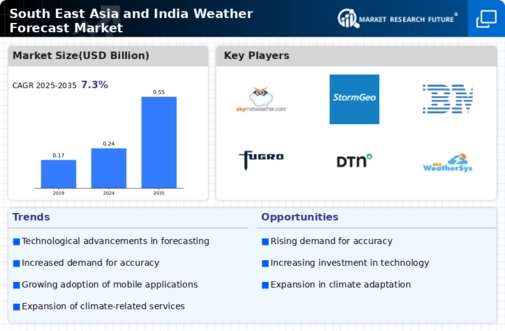Market Analysis
In-depth Analysis of South East Asia and India Weather Forecast Market Industry Landscape
The South East Asia and India Weather Forecast Market dynamics are shaped by a multitude of factors reflecting the region's geographic diversity, technological advancements, economic development, and climate variability. Weather forecasting plays a crucial role in various sectors, including agriculture, aviation, maritime, energy, disaster management, and tourism, where accurate and timely weather information is essential for decision-making, risk management, and operational planning.
One significant driver of the demand for weather forecasting services in South East Asia and India is the region's vulnerability to extreme weather events, including tropical cyclones, monsoon rains, droughts, floods, and heatwaves. With its diverse climate patterns and geography, the region experiences a wide range of weather phenomena that can have significant socio-economic impacts, including crop damage, infrastructure disruption, supply chain disruptions, and loss of life. Weather forecasting services help governments, businesses, and communities prepare for and mitigate the impacts of extreme weather events by providing early warnings, risk assessments, and decision support tools.
Technological advancements play a crucial role in shaping the dynamics of the weather forecast market in South East Asia and India. Innovations in meteorological instrumentation, satellite technology, weather modeling, data assimilation, and computing power enable meteorological agencies and private weather service providers to improve the accuracy, resolution, and lead time of weather forecasts. High-resolution numerical weather prediction models, satellite remote sensing data, and radar observations provide valuable insights into atmospheric processes, weather patterns, and severe weather phenomena, enabling more precise and reliable weather forecasts tailored to specific regions and applications.
Furthermore, economic factors such as agriculture, transportation, energy production, and tourism drive the demand for weather forecast services in South East Asia and India. Agriculture is particularly sensitive to weather variability, with farmers relying on weather forecasts to make planting, harvesting, and irrigation decisions, optimize crop yields, and minimize weather-related risks such as pests, diseases, and extreme temperatures. Similarly, aviation and maritime sectors rely on accurate weather forecasts for flight planning, route optimization, and operational safety, particularly in regions prone to convective weather, turbulence, and tropical cyclones.
Moreover, government policies, regulatory frameworks, and public investments influence the dynamics of the weather forecast market in South East Asia and India. National meteorological agencies, such as the India Meteorological Department (IMD) and the ASEAN Specialized Meteorological Centre (ASMC), provide weather forecasting services, warnings, and advisories to governments, industries, and the public to support disaster preparedness, emergency response, and public safety. Governments also collaborate regionally and internationally to share meteorological data, best practices, and capacity-building initiatives to strengthen weather forecasting capabilities and resilience to climate-related hazards.
However, challenges exist in the South East Asia and India Weather Forecast Market, including data gaps, infrastructure limitations, and communication barriers. Weather forecasting in South East Asia and India faces challenges such as sparse meteorological observation networks, limited access to real-time data, and gaps in weather modeling capabilities, particularly in remote or underdeveloped regions. Additionally, infrastructure limitations, including inadequate weather monitoring stations, radar coverage, and communication networks, constrain the accuracy and reliability of weather forecasts in certain areas, hindering the effectiveness of early warning systems and response efforts.











Leave a Comment